
Edward Winter

Chess Chatter & Chaff by P.H. Williams (Stroud, 1909), page 72 (illustration by Frederick Orrett)
For further information see our feature article on Williams.
Some lesser-known specimens of the seesaw (or windmill) combination are presented.
From a game won by V. Place (against ‘N.L.’) at the Café de la Régence, Paris in January 1922:

White to move
1 Nxg7 Kxg7 2 d5 Bg4 3 Rxf6 Bxd1 4 Rg6+ Kh7 5 Rg7+ Kh8 6 Rh7+ Kg8 7 Rh8 mate.
Source: La Stratégie, May 1922, page 113.
(2838)
Anybody who has never solved a mate in 12 may have a pleasant surprise when examining this position:
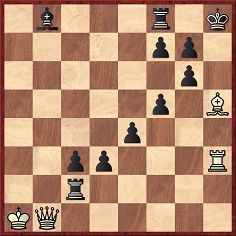
White to move
The composition, by O. Dehler, was published on page 452 of Deutsches Wochenschach, 15 December 1912. It is so straightforward that we hardly feel it necessary to publish the solution.
(3012)
1 d4 d5 2 c4 e6 3 Nc3 c5 4 cxd5 exd5 5 Nf3 Nc6 6 g3 Be6 7 Bg2 Nf6 8 O-O h6 9 b3 Be7 10 Bb2 O-O 11 e3 Qb6 12 dxc5 Qxc5 13 Ne2 Rad8 14 a3 Ne4 15 Rc1 Qb6 16 Ned4 Bg4 17 Nxc6 bxc6 18 Qd4 Qxd4 19 Nxd4 Nd2 20 Nxc6 Bg5 21 Nxd8 Nxf1 22 Nxf7 Nxe3 23 Nxg5 Nxg2
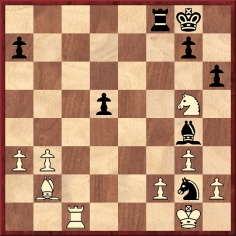
24 Rc7 hxg5 25 Rxg7+ Kh8 26 Rxa7+ Kg8 27 Rg7+ Kh8 28 Rxg5+ Kh7 29 Rg7+ Kh6 30 Rxg4 Kh5 31 Rd4 and White won (Black being mated at move 55).
Source: Schweizerische Schachzeitung, July 1913, pages 107-108.
B. de Oliveira and M. Kiss – R. Réti and L. Vianna1 e4 Nf6 2 e5 Nd5 3 c4 Nb6 4 b3 d6 5 Bb2 dxe5 6 Bxe5 Nc6 7 Bb2 Bf5 8 d4 e6 9 Be2 Bb4+ 10 Kf1 Qd7 11 c5 Nd5 12 a3 Bxb1 13 axb4 Bg6 14 b5 Ncb4 15 Qd2 O-O 16 Nf3 Qe7 17 h4 Qf6 18 h5 Be4 19 Ng5 Bxg2+ 20 Kxg2 Nf4+ 21 Kf1 Qxg5 22 Rg1 Qf5 23 d5 Qh3+ 24 Ke1 Nbd3+ 25 Bxd3 Nxd3+
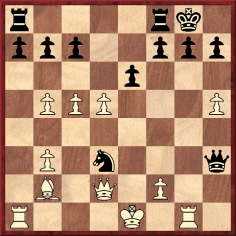
26 Qxd3 Resigns.
Source: American Chess Bulletin, March 1925, page 60.
The Bulletin quoted Aubrey Stuart’s eye-witness report in the Brazilian American:
‘Réti is a swarthy black-haired man in the prime of life. His spacious occiput and neck show nerve control and a plentiful supply of blood to the brain. Round shoulders and long straddling legs detract from his appearance when he rises, but seated at play he is an interesting figure.’
(2487)
A game from page 236 of the September 1957 BCM:
C. Chaurang (France) – B.J. Moore (England)1 e4 c5 2 d4 cxd4 3 Nf3 Nc6 4 Nxd4 Nf6 5 Nc3 d6 6 Bg5 e6 7 Qd2 a6 8 O-O-O h6 9 Bf4 e5 10 Nxc6 bxc6 11 Bxe5 Bg4 12 Bxf6 Qxf6 13 Be2 Be6 14 f4 Be7 15 Rhe1 O-O 16 Bf3 Rab8 17 e5 dxe5 18 fxe5 Qh4 19 Ne4 Bd5 20 Kb1 Qxh2 21 Re2 Qxe5 22 Nc3
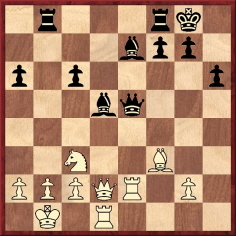
22…Rxb2+ 23 Kxb2 Rb8+ 24 Ka1 Ba3 25 Rxe5 Bb2+ 26 Kb1 Bxc3+ 27 Kc1 Bb2+ 28 Kb1 Bxe5+ 29 Kc1 Bb2+ 30 Kb1 Bc3+ 31 Kc1 Bxd2+ 32 White resigns.
On page 295 of the November 1957 BCM D.J. Morgan quoted W. Ritson Morry’s view in the Chess Supporter that this game surpassed Torre v Lasker, Moscow, 1925, for the following reasons:
‘(a) The pieces which enable the discovered check seesaw to be operated are not on the immediate scene as in the Torre game.
(b) Two sacrifices, and not one, are necessary to make the plan work properly.
(c) The quiet 24th move by the king’s bishop was not easy to foresee.
(d) The operation extends over a much greater area of the board and is accomplished with much greater concealment of intention.’
(2900)
From Die Schachspieler und ihre Welt (Berlin, 1911) comes this illustration by the book’s author, Arpad Bauer:

Very few chess books from that period featured pictures in colour.
(2901)
José Antônio Fabiano Mendes (Rio de Janeiro, Brazil) submitted the following game in C.N. 2911:
Helgi Olafsson – Jon Viktor Gunnarsson1 d4 d5 2 c4 c6 3 Nf3 Nf6 4 Nc3 dxc4 5 a4 Be6 6 Ng5 Bd5 7 e4 h6 8 exd5 hxg5 9 dxc6 Nxc6 10 d5 Na5 11 Bxg5 Qb6 12 Qc2 Qb4 13 Rd1 O-O-O 14 Be2 g6 15 Qd2 Bg7 16 O-O a6 17 Qe3 Rhe8 18 Bf3 Kb8 19 Rfe1 Nb3 20 d6 exd6 21 Qf4 Rxe1+ 22 Rxe1 Nc5 23 Bxf6 Nd3
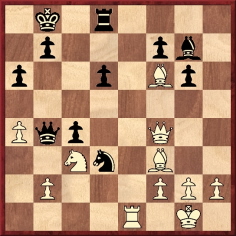
24 Bxd8 Nxf4 25 Re8 Ka7 26 a5 Bd4 27 Bc7 Bxf2+ 28 Kf1 Qxb2 29 Bb8+ Ka8 30 Bxd6+ Ka7 31 Bb8+ Resigns.
Of the games involving P.W. Sergeant that we have reviewed, one of the most interesting is this loss, given in C.N. 3190:
Singapore (J.B. Elcum, W. Craig, S. Rosembaum and P.A. Reutens) – Hong Kong (P.W. Sergeant, T.H. Reid, M.J. Dannenberg, E.J. Moses and P.C. de Souza)1 e4 e5 2 f4 exf4 3 Nf3 g5 4 h4 g4 5 Ng5 h6 6 Nxf7 Kxf7 7 d4 f3 8 gxf3 Be7 9 Bc4+ d5 10 Bxd5+ Kg7 11 O-O g3 12 f4 Nf6 13 Nc3 h5 14 f5 Ng4 15 Kg2 Bxh4 16 Rf4 Nf2 17 Qf3 Qg5 18 e5 Nc6 19 f6+ Kg6 20 Ne4 Nxe5 21 Nxg5 Nxf3 22 Bf7+ Kxg5
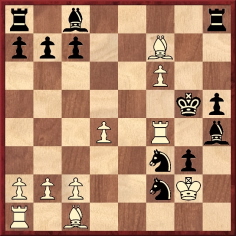
The Singapore team now telegraphed the unusual seesaw line 23 Rxf3+ Kg4 24 Rf4+ Kg5 25 Rxf2+ Kg4 26 Rf4+ Kg5 27 Rf1+ Kg4 28 Bc4 Re8 29 f7, and Black resigned.
Source: La Stratégie, 17 September 1902, pages 277-278. The magazine took the score and notes by J.B. Elcum from the Singapore Free Press.
[Addition on 25 October 2010: Olimpiu G. Urcan (Singapore) writes:
‘I believe that “Rosembaum” should read “Rosenbaum”. This little-known player made a few appearances in local championships, and his name was invariably given as “S. Rosenbaum”. By 1905 he was referred to as the head of the Belgian Consulate in Singapore. The two-game match began in late March 1902, and the Straits Times of 24 March 1902 (page 5) had “S. Rosenbaum”. This particular game had finished by 19 July 1902; the chess column in the Singapore Free Press of that day (page 3) published it with the notes by Elcum which were subsequently given by La Stratégie.’]
The following position was labelled ‘D. Harrwitz Date? Before 1858’ on page 430 of the November 1913 issue of La Stratégie:

White, to move, is said to have won thus: 1 Rxg7 Rxd1 2 Rxe7+ Kg8 3 Rg7+ Kh8 4 Rxd7+ Kg8 5 Rg7+ Kh8 6 Rxc7+ Kg8 7 Rg7+ Kh8 8 Rxb7+ Kg8 9 Rxb8+ Kh7 10 Rh8+ Kg6 11 Rg8+ Kh7+ 12 Rg7+ Kh8 13 Rxg5+ Kh7 14 Rg7+ Kh8 15 Rxa7+ Kg8 16 Rxa6 Rxf1+ 17 Kg2.
Next is a spectacular odds game won by Amos Burn which Richard Forster took from pages 289-290 of the July 1896 BCM and presented in his article ‘Quiet Master in Stormy Waters’ on pages 12-13 of CHESS, July 2001:
Amos Burn – G. Whitehead1 e4 e5 2 Nf3 Nc6 3 Bc4 Be7 4 d4 exd4 5 c3 d6 6 Qb3 Ne5 7 Nxe5 dxe5 8 Bxf7+ Kf8 9 O-O Nf6 10 f4 Qd6 11 fxe5 Qxe5 12 Bf4 Qxe4 13 Rae1 Qc6 14 Bg5 Qb6 15 Rxf6 Qxb3
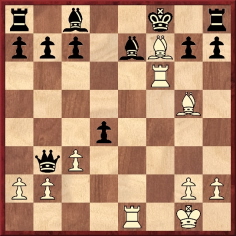
16 Bh5+ gxf6 17 Bh6+ Kg8 18 Rxe7

18…Qe6 (Mason: ‘Or 18...Be6 19 Rg7+ Kf8 20 Rxc7+ Kg8 21 Rg7+ Kf8 22 Rxb7+ Kg8 23 Rg7+ Kf8 24 Rxa7+ and mates in three more moves. Either way, a very remarkable and beautiful ending.’) 19 Rg7+ Kf8 20 Rd7+ Kg8 21 Rd8+ and mates next move.
Finally, the position below was published in an article by Josef Krejcik on pages 41-42 of the February 1925 Wiener Schachzeitung:
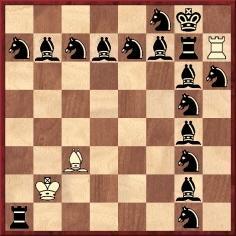
White wins as follows: 1 Rxg7+ Kh8 2 Rxf7+ Kg8 3 Rg7+ Kh8 4 Rxe7+ Kg8 5 Rg7+ Kh8 6 Rxd7+ Kg8 7 Rg7+ Kh8 8 Rxc7+ Kg8 9 Rg7+ Kh8 10 Rxb7+ Kg8 11 Rg7+ Kh8 12 Rxa7+ Kg8 13 Rg7+ Kh8 14 Rxg6+ Kh7 15 Rg7+ Kh8 16 Rxg5+ Kh7 17 Rg7+ Kh8 18 Rxg4+ Kh7 19 Rg7+ Kh8 20 Rxg3+ Kh7 21 Rg7+ Kh8 22 Rxg2+ Kh7 23 Rg7+ Kh8 24 Rxg1+ Kh7 25 Rg7+ Kh8 26 Kxa1 Nh7 27 Rg6+ Nf6 28 Rxh6+ Kg7 29 Rxf6.
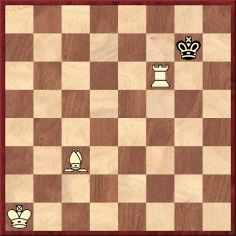
The above composition was also given by Krejcik on pages 41-42 of his book Artige und unartige Kinder der Schachmuse (Leipzig, 1925).
(3312)
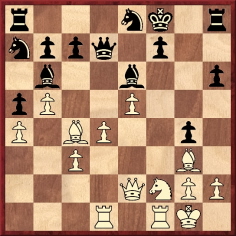
J.H. Zukertort – N.N., London, 1879
White played 21 Nxg4 Bxg4 22 Qxg4 Qxg4 23 Rxf7+ Kg8 24 Rxc7+ Kf8 25 Rf7+ Kg8 26 Rxb7+ Kf8 27 Rf7+ Kg8 28 Rxa7+ Kf8 29 Rf1+ Nf6 30 Rxa8+ Kg7 31 exf6+ Kg6 32 Rxh8 Resigns.
Source: Chess Monthly, January 1881, page 153.
(3338)
In C.N. 3301 Yvette Seirawan (Amsterdam) asked about the origins of ‘windmill’ and ‘seesaw’ as English-language terms for the combination known in German as ‘Zwickmühle’.
‘Seesaw’ was used by Steinitz (‘a pretty so-called seesaw of checks finishes the game’) when annotating his loss against James McConnell in New Orleans, 1886, which was presented as a ‘hitherto unpublished game’ on pages 250-251 of the September 1897 American Chess Magazine. Earlier occurrences of the term are sought.
Zwickmühle was Nimzowitsch’s word in Mein System, but the extent of its prior use has yet to be ascertained, another open matter being the first appearance of ‘windmill’ in chess literature. The English translation, My System, put ‘seesaw’.
The meaning of Zwickmühle is not ‘windmill’ but ‘double mill’, i.e. the term used in Mühlespiel (the board game known in English as Nine Men’s Morris). In his book Brettspiele der Völker (Berlin, 1931) Emanuel Lasker had (on pages 232-234) a section about Mühle, including references to Zwickmühle. As regards chess, Tim Krabbé devoted a chapter to ‘The art of the zwickmühle’ on pages 122-147 of Chess Curiosities (London, 1985). For complementary information, see pages 85-107 of the same author’s Nieuwe Schaakkuriosa (Amsterdam, 1977).
The German expression ‘in der Zwickmühle sitzen’ is translated by our dictionary as ‘to be in a catch-22 situation’ and ‘to be in a dilemma’. This figurative meaning is lost in ‘windmill’ and ‘seesaw’.
Regarding the seesaw, or windmill, manoeuvre, the earliest instance of the word ‘seesaw’ found so far appeared on page 251 of the American Chess Magazine, September 1897:
‘A pretty so-called seesaw of checks finishes the game ...’
John Simpson (Oxford, England), the Chief Editor of the Oxford English Dictionary, notes an earlier, different, use of the term on page 263 of the Chess Player’s Chronicle, 1849:
‘This see-saw is pretty enough. White evidently must not accept the proffered donum.’
The proffered donum was the black rook, the note being appended to Black’s 38th move. The full game, from pages 262-263 of the Chronicle, was:
Henry Edward Bird – Elijah Williams1 e4 e6 2 d4 d5 3 exd5 exd5 4 Nf3 Nf6 5 Bd3 Bd6 6 O-O O-O 7 c3 Ne4 8 Nbd2 f5 9 c4 c6 10 cxd5 cxd5 11 Qb3 Kh8 12 Qc2 Nc6 13 a3 h6 14 b4 a6 15 Nb3 Qf6 16 Bb2 g5 17 Nfd2 g4 18 f4 gxf3 19 Rxf3 Qh4 20 Rh3 Qg5 21 Re1 Rg8 22 Nf3 Qg7 23 Ne5 Bxe5 24 dxe5 Be6 25 Bc1 f4 26 Rh4 Raf8 27 Bxf4 Ng5 28 Kh1 Ne7 29 Nd4 Bf7 30 e6 Bg6 31 Bxg6 Qxg6 32 Qxg6 Rxg6 33 Bxg5 Rxg5 34 Rxh6+ Kg7 35 Rh3 Re5 36 Rg3+ Ng6
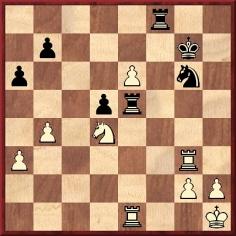
37 Rc1 Rc8 38 Rf1 Rf8 39 Kg1 Rxf1+ 40 Kxf1 Re4 41 e7 Kf7 42 Nf5 Rf4+ 43 Rf3 b6 44 Kf2 a5 45 bxa5 bxa5 46 Kg3 Rxf3+ 47 Kxf3 Ne5+ 48 Ke3 Nc4+ 49 Kd4 Nxa3 50 Kxd5 Nb5 51 Nd6+ Nxd6 52 Kxd6 Ke8 53 Kc5 and White won.
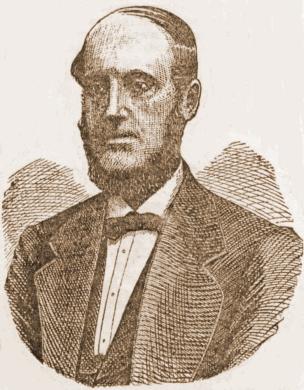
Henry Edward Bird (Scientific American Supplement, 20 October 1877, page 1502)
(5853)
Oliver Dunne (Dublin) submits a game with the unusual possibility of the seesaw/windmill manoeuvre occurring with either rook:
Oliver Dunne – Pat Fitzsimons1 g3 e5 2 Nf3 Nc6 3 d4 exd4 4 Nxd4 Qf6 5 c3 Bc5 6 Be3 Nxd4 7 cxd4 Bb4+ 8 Nd2 Ne7 9 Bg2 O-O 10 O-O Bxd2 11 Bxd2 Qxd4 12 Qc2 c6 13 Bc3 Qg4 14 Rad1 d5 15 Rd4 Qg6 16 Qxg6 Nxg6 17 e4 dxe4 18 Bxe4 Be6 19 Rb4 Bh3 20 Rc1 Rab8 21 f4 Bd7 22 Bxg6 hxg6 23 Be5 Ra8 24 Rxb7 Be6 25 Rxc6 Bd5
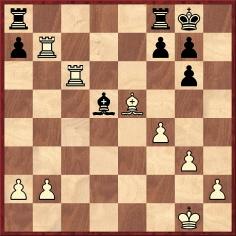
26 Rxg6 Bxb7 27 Rxg7+ Kh8 28 Rxf7+ Kg8 29 Rg7+ Kh8 30 Rxb7+ Kg8 31 Rg7+ Kh8 32 Rxa7+ Kg8 33 Rg7+ Kh8 34 g4 Rfe8 35 Rg5+ Kh7 36 Rg7+ Kh8 37 Re7+ Kg8 38 Rxe8+ Rxe8 39 h4 Kf7 40 Kf2 Rc8 41 Bc3 Rd8 42 f5 Rd1 43 Kg2 Rd3 44 g5 Rd5 45 g6+ Kg8 46 f6 Rd6 47 f7+ Kf8 48 Bb4 Kg7 49 Bxd6 Kxg6 50 f8(R) Resigns.
(7190)
Eduardo Bauzá Mercére (New York, NY, USA) offers a game from the 1958 Spanish championship which has the seesaw manoeuvre:
Arturo Pomar Salamanca – Eduardo Pérez Gonsalves
Valencia, 28 June 1958
Sicilian Defence
1 e4 c5 2 Nf3 e6 3 d4 cxd4 4 Nxd4 a6 5 Nc3 Bb4 6 Qg4 Nf6 7 Qxg7 Rg8 8 Qh6 Rg6 9 Qe3 Ng4 10 Qd3 d5 11 exd5 Qxd5 12 Bd2 Qe5+ 13 Be2 Bc5 14 Be3 Nxe3 15 fxe3 Bd7 16 O-O-O Nc6 17 Bf3 O-O-O 18 Ne4 Be7 19 Qc3 Bf8 20 Rd3 f5 21 Nxc6 Qxc3 22 Na7+ Kb8 23 Nxc3 Kxa7 24 Rhd1 Rg7 25 e4 Kb8 26 exf5 exf5 27 Ne2 Be7 28 Nd4 Rc8 29 Kb1 Bf6 30 Nb3 Bb5 31 Rd5 f4 32 Rf5 Bg5 33 Nc5 Bd8 34 Ne6 Rd7 35 Rxd7 Bxd7
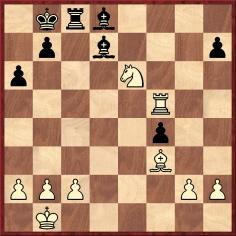
36 Rf7 Bxe6 37 Rxb7+ Ka8 38 Rxh7+ Kb8 39 Rb7+ Ka8 40 Re7+ Kb8 41 Rxe6 a5 42 Rc6 Rxc6 43 Bxc6 Kc7 44 Bf3 Kd6 45 c3 Kc5 46 Kc2 Bf6 47 Kd3 a4 48 Bd1 Kb5 49 Ke4 a3 50 bxa3 Bxc3 51 Kxf4 Kc6 52 h4 Kd6 53 Bb3 Resigns.
Source: El Ajedrez Español, 1958, page 248.
(7881)
To the Chess Notes main page.
To the Archives for other feature articles.
Copyright: Edward Winter. All rights reserved.